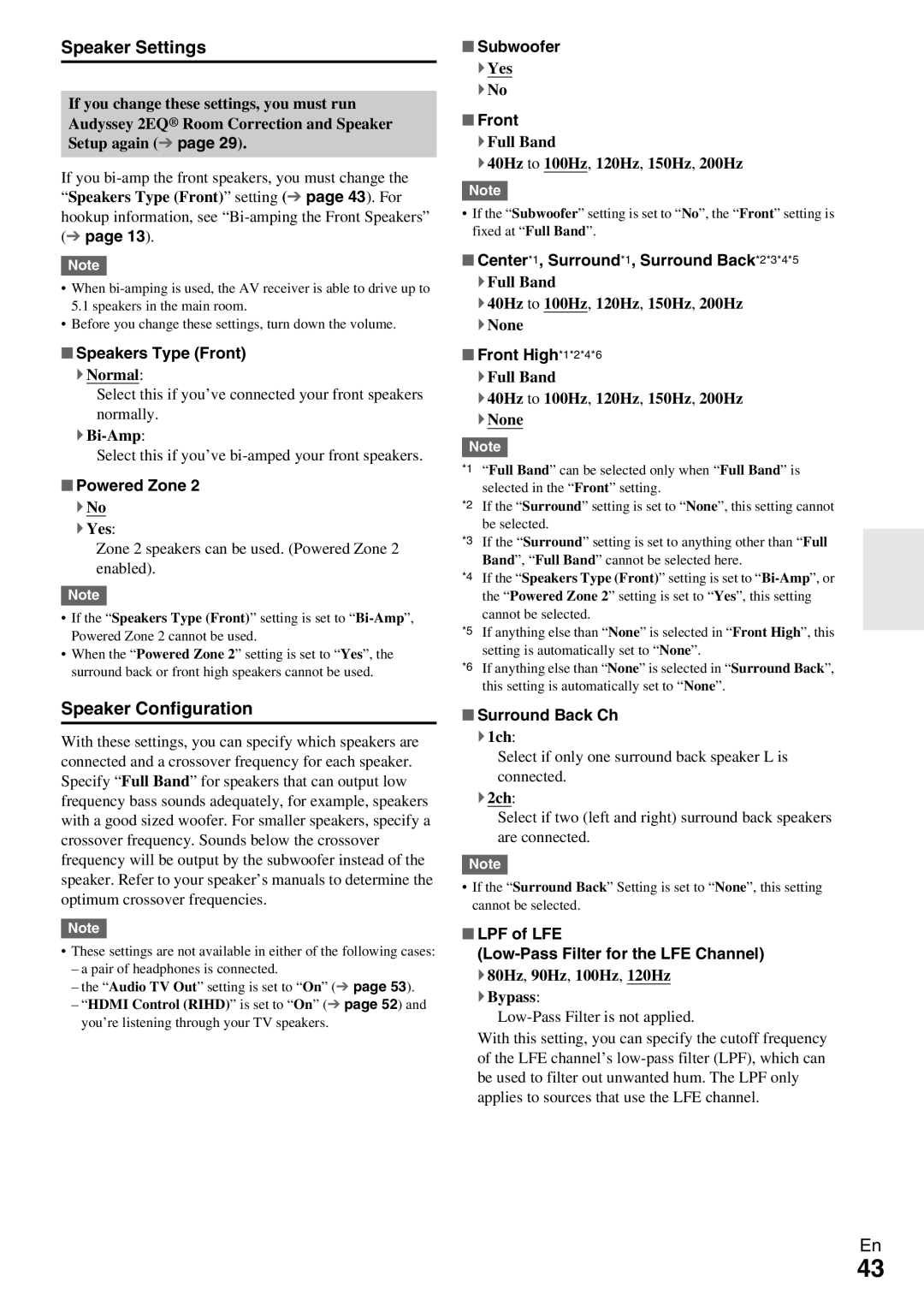TX-NR579
Away from the rear panel or wall, creating a flue-like
Local regulations when disposing of batteries
10 cm 4 at the rear. The rear edge of the shelf or
Board above the apparatus shall be set 10 cm
Batteries and Heat Exposure Warning
Precautions
Power
Preventing Hearing Loss Caution
Aiming the remote controller
Supplied Accessories
Make sure you have the following accessories
Installing the batteries
Contents
Processing
Features
Services available may vary depending on the region
Amplifier
Front Panel
Front & Rear Panels
For detailed information, see the pages in parentheses
Display
Rear Panel
Power cord
UREMOTE Control jack
See Connecting the AV Receiver for connection pages 11 to
Controlling the AV Receiver
Remote Controller
Screw-type speaker terminals
Connecting the AV Receiver
Connecting Your Speakers
Connecting the Speaker Cables
Speaker Connection Precautions
Speaker Configuration
Attaching the Speaker Cable Labels
Bi-amping the Front Speakers
Using a Powered Subwoofer
Hdmi cable
Connecting AV components
About AV Connections
AV Cables and Jacks
Audio Return Channel ARC function
Connecting Components with Hdmi
Jack Components Assignable
Jack/Port Components Assignable
Connecting Your Components
How to record a video source
Remote Control
Connecting Onkyo uComponents
Connecting a Recording Component
System On/Auto Power On
Assembling the AM loop antenna
Connecting the Antennas
Connecting the Power Cord
Plug the power cord into an AC wall outlet
AV receiver comes on, the display lights
Turning On/Off the AV Receiver
Turning On
Turning Off
Playing the Connected Component
Controlling Contents of USB or Network Devices
Selecting the Language for the Onscreen Setup Menus
Playback
Playing an iPod/iPhone via USB
Understanding Icons on the Display
Enter
Listening to Internet Radio
Playing a USB Device
Registering My Favorites*1
Listening to Other Internet Radio
Top menu of Internet Radio
Remote Playback
Windows Media Player 11 Setup
Windows Media Player 12 Setup
Playing Music Files on a Server
Listening to AM/FM Radio
Using Remote Playback
Using the Tuner
Tuning into Radio Stations
Using RDS
Presetting AM/FM Stations
Mode
Finding Stations by Type PTY
Displaying Radio Text RT
Listening to Traffic News TP
Using the Automatic Speaker Setup
Using Basic Functions
Measurement procedure
Use q/wto select a target, and use e/rto change the setting
When you’ve finished making the settings, press
When prompted, repeat step
` Cancel
Changing the Speaker Setup Manually
Error Messages
Selecting Listening Modes
Using the Listening Modes
Input Source
Following audio formats are supported by the listening mode
About Listening Modes
Explanatory Notes
Listening Modes
Onkyo-Original DSP Listening Modes
Height
Resolution Audio
Dolby Pro Logic
Dolby Pro Logic IIz
Use this mode with any stereo movie e.g., TV, DVD, VHS
Listening Mode Description Input Speaker Source Layout Neo6
That fully envelops the listener
Using the Sleep Timer
Using the Home Menu
Setting the Display Brightness
VCR/DVR
Displaying Source Information
Changing the Input Display
Muting the AV Receiver
Recording
Using Headphones
AV Recording
On-screen Setup Menus Common Procedures in Setup Menu
Advanced Setup
Explanatory Notes
Hdmi Input
Resolution
Input/Output Assign
Monitor Out
Digital Audio Input
Speaker Setup
Input selector Default assignment
Component Video Input
Speaker Settings
Unit
Speaker Distance
Level Calibration
Double Bass
Multiplex/Mono
Audio Adjust
Dolby
Theater-Dimensional
Source Setup
Audyssey
Reference Level
Dynamic Volume
Sync
IntelliVolume
Name Edit
Picture Adjust
Audio Selector
Charge Mode
DTS/DTS-ES/DTS-HD
Listening Mode Preset
Volume Setup
Miscellaneous
Tuner
Hardware Setup
OSD Setup
Remote ID
Auto Standby
Network
Firmware Update
Dhcp
Lock Setup
Remote Controller Setup
Using the Audio Settings
Music Optimizer
Late Night
CinemaFILTER
Making Zone 2 Connections
Connecting Your Zone 2 Speakers Directly to the AV receiver
Connecting the Zone Speakers to an Additional Amplifier
Zone
Muting Zone
Adjusting the Volume for Zone
Operating on the remote controller
Controlling Zone 2 Components
IPod/iPhone Playback via Onkyo Dock
Using the Onkyo Dock
UP-A1 Dock
RI Dock
Controlling Your iPod/iPhone
Available buttons
Controlling Other Components
Preprogrammed Remote Control Codes
Looking up for Remote Control Code
Entering Remote Control Codes
Controlling Other Components
Remote Control Codes for Onkyo Components Connected via u
Resetting Remote Mode Buttons
Resetting the Remote Controller
Search
Setup
Buttons Input TV VOL q / w
Guide
Power
Troubleshooting
Audio
About DTS signals
There’s no sound with a certain signal format
Can’t select the Pure Audio listening mode
Speaker volume cannot be set as required
Video
Remote Controller
Tuner
Music Server and Internet Radio
UP-A1 Dock for iPod/iPhone
Recording
Zone
Others
USB Device Playback
Component Video OUT
Important Note Regarding Video Playback
Connecting to the Network
Network/USB Features
Network Requirements
Remote playback
Server Requirements
USB Device Requirements
Server playback
About Dlna
Supported Audio File Formats
Before you start
Firmware Update
Update procedure
Updating the Firmware via Network
Updating the Firmware via USB
Troubleshooting
Errors during an update via network
Error Code Description
Errors during an update via USB
Signal Selection
Connection Tips and Video Signal Path
Video Connection Formats
OUT
Audio Connection Formats
Supported Audio Formats
About Hdmi
About Copyright Protection
About p-compatible components
Using an RIHD-compatible TV, Player, or Recorder
Operations that can be performed with Connection
Operate with the remote controller
How to connect and setup
Confirm the connecting and setting
Confirm the settings
Video Section
Specifications
Amplifier Section
General
1080p 1080i 720p 480p/576p 480i/576i Component Composite
Video Resolution Chart
Available resolutions 3840 ⋅ 2160 24/25/30 Hz
Output
Onkyo Europe Electronics GmbH UK Branch
Onkyo Europe Electronics GmbH

